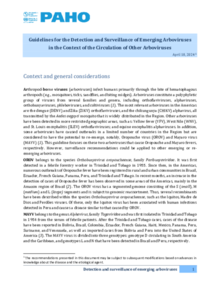Guidelines for the Detection and Surveillance of Emerging Arboviruses in the Context of the Circulation of Other Arboviruses

|
Arthropod-borne viruses (arboviruses) infect humans primarily through the bite of hematophagous arthropods (e.g., mosquitoes, ticks, sandflies, and biting midges). Arboviruses constitute a polyphyletic group of viruses from several families and genera, including orthoflaviviruses, alphaviruses, orthobunyaviruses, phleboviruses, and coltiviruses (1). The most relevant arboviruses in the Americas are the dengue (DENV) and Zika (ZIKV) orthoflaviviruses, and the chikungunya (CHIKV) alphavirus, all transmitted by the Aedes aegypti mosquito that is widely distributed in the Region. Other arboviruses have been detected in more restricted geographic areas, such as: Yellow fever (YFV), West Nile (WNV), and St. Louis encephalitis (SLEV) orthoflaviviruses; and equine encephalitis alphaviruses. In addition, some arboviruses have caused outbreaks in a limited number of countries in the Region but are considered to have the potential to re-emerge, notably, Oropouche virus (OROV) and Mayaro virus (MAYV) (1). This guideline focuses on these two arboviruses that cause Oropouche and Mayaro fevers, respectively. However, surveillance recommendations could be applied to other emerging or re-emerging arboviruses. OROV belongs to the species Orthobunyavirus oropoucheense, family Peribunyaviridae. It was first detected in a febrile forestry worker in Trinidad and Tobago in 1955. Since then, in the Americas, numerous outbreaks of Oropouche fever have been registered in rural and urban communities in Brazil, Ecuador, French Guiana, Panama, Peru, and Trinidad and Tobago. In recent months, an increase in the detection of cases of Oropouche fever has been observed in some areas of the Americas, mainly in the Amazon region of Brazil (2). The OROV virus has a segmented genome consisting of the S (small), M (medium) and L (large) segments and is subject to genomic reassortment. Thus, several recombinants have been described within the species Orthobunyavirus oropoucheense, such as the Iquitos, Madre de Dios and Perdões viruses. Of these, only the Iquitos virus has been associated with human infections detected in Peru and causes a disease similar to that caused by OROV. MAYV belongs to the genus Alphavirus, family Togaviridae and was first isolated in Trinidad and Tobago in 1954 from the serum of febrile patients. After the Trinidad and Tobago cases, cases of the disease have been reported in Bolivia, Brazil, Colombia, Ecuador, French Guiana, Haiti, Mexico, Panama, Peru, Suriname, and Venezuela, as well as imported cases from Bolivia and Peru into the United States of America (3). The MAYV virus is divided into three genotypes: genotype D circulating in South America and the Caribbean, and genotypes L and N that have been detected in Brazil and Peru, respectively. |
